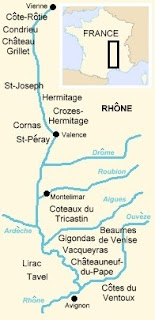 I really like the Rhone wines bcos it is quite value for money. Think it is quite a good balance of stength and body to go along with. Some of my fav producers include Marcoux, Domanine de Pegau, Pierre Usseglio and Vieille Julienne.
I really like the Rhone wines bcos it is quite value for money. Think it is quite a good balance of stength and body to go along with. Some of my fav producers include Marcoux, Domanine de Pegau, Pierre Usseglio and Vieille Julienne.The Rhone river begins life way to the north of Switzerland. It widens to become the central region of the rhone valley, which spans roughly btw Lyons and Avignon. Divided into north/south at the town of Valence.
The Northern rhone is a land of steep slopes carved into the granite hillsides. Vines cling to near vertical surface. Predominant red wine area but some expensive wines originate here. Southern rhone gives way to a broad valley floor. Enormous quantity of mediocre reds produced but pockets of superb quality exist.
North Rhone - Syrah (called shiraz outside france) and Viognier for whites although it is used sparingly in reds as well. Marsanne and Rousanne are also grown for whites. In the South Rhone, grenache, syrah and Mouvredre and Cinsaut are used for red and Grenanche Blanc, Picpoul, Marsanne and Rousanne are used for the whites.
The famous wine of Hermitage takes it names fom the hill of Hermitage above the town of Tain. Deep, dark and serious, these are strapping, tannic and vigourous in youth as they grow more finese and complex as they age over 20yrs or more. White hermitage is also produced.
Cote Rote can contain up to 20% of white viognier. More often than not, its 100% syrah. More approachable than Hemitage, more aromatic and graceful. Crozes hermitage are more easily available made from less formidable slopes around hermitage. It is a syrah with some quality but lower priced. St Joseph and Cornas are other syrahs with strong personality but on opp bank of the river.
Northern rhone also produced some very rare and expensive white wines from viognier grape such as Condrieu and Chateau Grillet. Clean and highly aromatic and at the same time powerful and full bodied. Just south of Côte Rôtie we find Condrieu, and here the colour changes from red to white. This is a wine made solely from the Viognier grape, a lovely variety, which is also used to add interest to Côte Rôtie. This, in my opinion, is the Rhône's finest white wine. At its best it is heady and intense, but it maintains balance, with fresh acidity and sensible alcohol - this latter characteristic being the point on which all New World Viognier wines disappoint me - they can be intense, but generally have excessive, mouth-searing alcohol. Unlike many wines of the Rhône, Condrieu is best enjoyed young - within a few years of bottling. St Joseph is prob the North's most underrated appellation for red and white. Juicy and best drunk young <10yrs.
Top northern producers include Guigal, Jaboulet, Chapoutier, Chave and Grippat.
For the southern A vast amount of light, easy-drinking wine is made, sometimes using the technique of carbonic maceration found in Beaujolais. The Cotes Du Rhone consists of 17 villages. Rather like the Beaujolais Villages, the best are sometimes labelled with the village name, appearing only in tiny print: Cairanne, Sablet, St-Gervais, Seguret, etc. These should be superior wines, spicy, strong and suitable candidates for 5 to 10 years cellaring. They have lower yields and higher alcohol than the basic appellation. Whites in the south tend also to be blends. Modern techniques mean they are usually fresh and enjoyable.
The name CDP means "The Pope's new castle", a reference to when nearby Avignon became the home of the papal court in the 14th century. No fewer than 13 grape varieties are permitted in CDP, which is easily the leading wine of the Southern Rhone. In theory this means the wine-maker has various options at his or her disposal each vintage depending on how individual grape varieties have performed. In practice, most CDP is made up of the 3 highest quality grapes: Grenache, Mouvredre and Syrah. This is a wine which is invariably high-alcohol, heady and rich.
The wines of Gigondas and Vacqueyras are built in a similar style to CDP and can offer high quality, often substantially cheaper than their famous neighbour.
A good deal of quality fortified sweet wine is made too, the most famous example being the Muscats of Beaumes-de-Venise. These are "Vins Doux Naturels", that is they are fortified wines, made by adding spirit part way through fermentation. This produces a wine that is high in alcohol and sugar, and is dominated by grapey flavours.
The Rhône Valley has been fortunate with a recent run of good vintages in 2000, 1999 (north better), and 1998. 2001 was excellent in the south, whereas floods ruined the 2002 vintage. Other good vintages include, for the north, 1995, 1994, 1991 (Côte Rôtie and Cornas only), 1990, 1989, 1988, 1987, 1986, 1985, 1983, 1982, 1980 and 1978. For the south, 1995, 1994, 1990, 1989, 1988, 1985 and 1978.
No comments:
Post a Comment